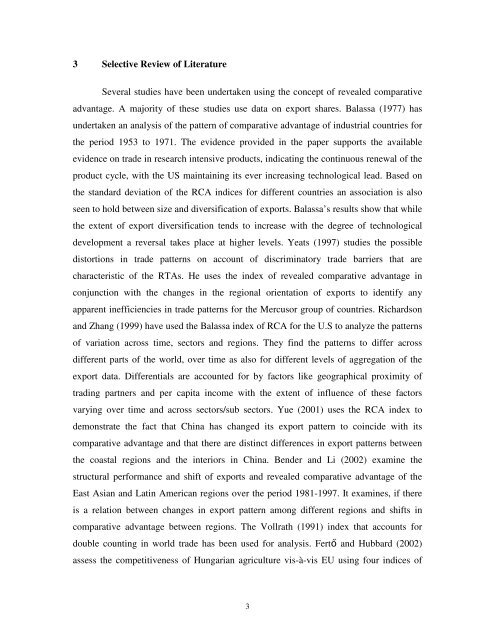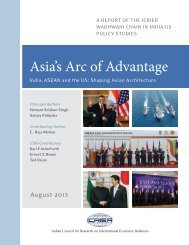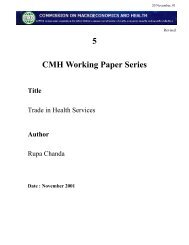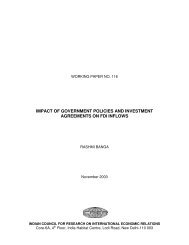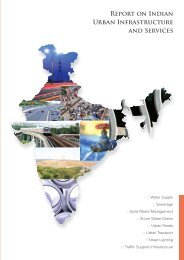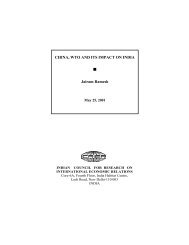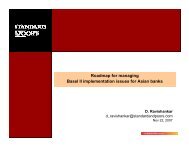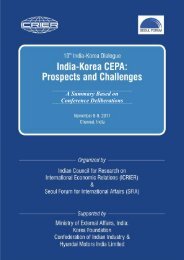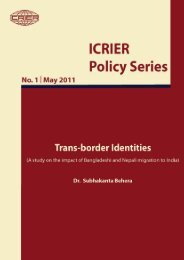an analysis for india and china - icrier
an analysis for india and china - icrier
an analysis for india and china - icrier
Create successful ePaper yourself
Turn your PDF publications into a flip-book with our unique Google optimized e-Paper software.
3 Selective Review of Literature<br />
Several studies have been undertaken using the concept of revealed comparative<br />
adv<strong>an</strong>tage. A majority of these studies use data on export shares. Balassa (1977) has<br />
undertaken <strong>an</strong> <strong>an</strong>alysis of the pattern of comparative adv<strong>an</strong>tage of industrial countries <strong>for</strong><br />
the period 1953 to 1971. The evidence provided in the paper supports the available<br />
evidence on trade in research intensive products, indicating the continuous renewal of the<br />
product cycle, with the US maintaining its ever increasing technological lead. Based on<br />
the st<strong>an</strong>dard deviation of the RCA indices <strong>for</strong> different countries <strong>an</strong> association is also<br />
seen to hold between size <strong>an</strong>d diversification of exports. Balassa’s results show that while<br />
the extent of export diversification tends to increase with the degree of technological<br />
development a reversal takes place at higher levels. Yeats (1997) studies the possible<br />
distortions in trade patterns on account of discriminatory trade barriers that are<br />
characteristic of the RTAs. He uses the index of revealed comparative adv<strong>an</strong>tage in<br />
conjunction with the ch<strong>an</strong>ges in the regional orientation of exports to identify <strong>an</strong>y<br />
apparent inefficiencies in trade patterns <strong>for</strong> the Mercusor group of countries. Richardson<br />
<strong>an</strong>d Zh<strong>an</strong>g (1999) have used the Balassa index of RCA <strong>for</strong> the U.S to <strong>an</strong>alyze the patterns<br />
of variation across time, sectors <strong>an</strong>d regions. They find the patterns to differ across<br />
different parts of the world, over time as also <strong>for</strong> different levels of aggregation of the<br />
export data. Differentials are accounted <strong>for</strong> by factors like geographical proximity of<br />
trading partners <strong>an</strong>d per capita income with the extent of influence of these factors<br />
varying over time <strong>an</strong>d across sectors/sub sectors. Yue (2001) uses the RCA index to<br />
demonstrate the fact that China has ch<strong>an</strong>ged its export pattern to coincide with its<br />
comparative adv<strong>an</strong>tage <strong>an</strong>d that there are distinct differences in export patterns between<br />
the coastal regions <strong>an</strong>d the interiors in China. Bender <strong>an</strong>d Li (2002) examine the<br />
structural per<strong>for</strong>m<strong>an</strong>ce <strong>an</strong>d shift of exports <strong>an</strong>d revealed comparative adv<strong>an</strong>tage of the<br />
East Asi<strong>an</strong> <strong>an</strong>d Latin Americ<strong>an</strong> regions over the period 1981-1997. It examines, if there<br />
is a relation between ch<strong>an</strong>ges in export pattern among different regions <strong>an</strong>d shifts in<br />
comparative adv<strong>an</strong>tage between regions. The Vollrath (1991) index that accounts <strong>for</strong><br />
double counting in world trade has been used <strong>for</strong> <strong>an</strong>alysis. Fertı <strong>an</strong>d Hubbard (2002)<br />
assess the competitiveness of Hungari<strong>an</strong> agriculture vis-à-vis EU using four indices of<br />
3


